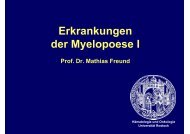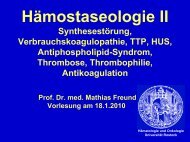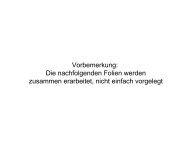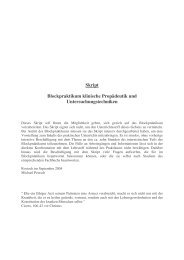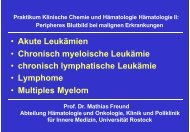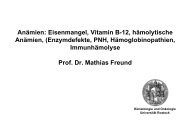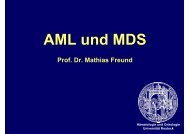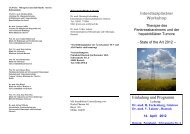Das normale Blutbild - Hämatologie und Onkologie Rostock
Das normale Blutbild - Hämatologie und Onkologie Rostock
Das normale Blutbild - Hämatologie und Onkologie Rostock
Sie wollen auch ein ePaper? Erhöhen Sie die Reichweite Ihrer Titel.
YUMPU macht aus Druck-PDFs automatisch weboptimierte ePaper, die Google liebt.
<strong>Das</strong> <strong>normale</strong> <strong>Blutbild</strong>:<br />
Morphologie <strong>und</strong> Funktion<br />
der Zellen; Normalwerte<br />
Prof. Dr. M. Fre<strong>und</strong><br />
<strong>Hämatologie</strong> <strong>und</strong> <strong>Onkologie</strong><br />
Universität <strong>Rostock</strong>
Paul Ehrlich<br />
(1854-1915, Nobelpreis 1908)<br />
Färbetheorie<br />
(1878 mit Karl Weigert)
Normale<br />
Erythrozyten
Normalwerte <strong>Blutbild</strong> nach Wintrobe<br />
Männer<br />
Frauen<br />
Leukozytenzahl 3,8-10,6 x 10 3 /µl 3,6-11,0 x 10 3 /µl<br />
Hämoglobin 13-18 g/dl 12-16 g/dl<br />
Erythrozytenzahl 4,4-5,9 x 10 6 /µl 3,8-5,2 x 10 6 /µl<br />
MCV 80-100 fl 80-100 fl<br />
MCH 26-34 g/dl 26-34 g/dl<br />
Thrombozytenzahl 150-440 x 10 3 /µl 150-440 x 10 3 /µl<br />
Retikulozytenzahl 0,8-2,5%<br />
18.000-158.000 /µl<br />
0,8-4,0%<br />
18.000-158.000 /µl<br />
Umrechnungsfaktor Hb: 1 g/dl => 0,6206 mmol/l; 1 mmol/l => 1,611 g/dl<br />
Nach: Wintrobe, M.M., Lee, G.R., Boggs, D.R., et al. Clinical Hematology, Philadelphia:Lea and Febiger, 1981. Ed. 8 th
Normalwerte <strong>Blutbild</strong><br />
IKLA <strong>Rostock</strong> 2004 (http://www.ikcpb.med.uni-rostock.de/referenzwerte)<br />
Männer<br />
Frauen<br />
Leukozytenzahl 4,0 - 9,0 Gpt/l 4,0 – 9,0 Gpt/l<br />
Hämoglobin<br />
13,8 - 19,3 g/dl<br />
(8,6 - 12,0 mmol/l)<br />
12 - 16 g/dl<br />
(7,4 - 9,9 mmol/l)<br />
Hk 0,40 – 0,51 0,35 – 0,47<br />
Erythrozytenzahl 4,5 - 5,5 x 10 12 /µl 4,0 - 5,0 x 10 12 /µl<br />
MCV<br />
MCH<br />
MCHC<br />
Thrombozytenzahl<br />
Retikulozytenzahl 0,5 - 2,5%<br />
2 - 14 x 10 10 /l<br />
Umrechnungsfaktor Hb:<br />
83 – 93 fl<br />
1,55 – 1,90 fmol<br />
18,5 – 22,5 mmol/l<br />
150 - 450 x Gpt/l<br />
1 g/dl => 0,6206 mmol/l;<br />
1 mmol/l => 1,611 g/dl<br />
0,5 – 3,0%<br />
2 - 14 x 10 10 /l
Normalwerte Differentialblutbild<br />
Basophile Granulozyten Bas 1%<br />
Eosinophile Granulozyten Eos 5%<br />
Metamyelozyten Meta 1%<br />
Neutrophile Stabkernige Stab 8%<br />
Neutrophile Segmentkernige Seg 36 - 84%<br />
Lymphozyten Lymph 20 - 42%<br />
Monozyten Mono 15%
95% Konfidenzintervall <strong>und</strong> Differentialblutbild
Merkmale der neutrophilen Granulozyten<br />
Blast<br />
Myelozyt<br />
Stabkerniger<br />
Promyelozyt<br />
Metamyelozyt<br />
Segmentkerniger<br />
„Linksverschiebung“
Neutrophile Granulozyten<br />
Stabkerniger<br />
• Die dünnste Stelle des Kerns (Segment)<br />
darf nicht dünner als 1/3 der dicksten<br />
Stelle sein.<br />
Segmentkerniger (10 - 15 µm)<br />
• 1-4 Segmente<br />
Übersegmentierter<br />
• >5 Segmente
Neutrophile Granulozyten<br />
• Anheftung an die Gefäßwand<br />
• Chemotaxis<br />
• Migration<br />
• Anheftung von Erregern über Komplement<br />
• Phagozytose<br />
• Vernichtung durch Oxidation<br />
• Freisetzen von Entzündungsmediatoren
Neutrophile Granulozyten
Eosinophile Granulozyten<br />
• Eosinophiler:<br />
10 - 15 µm<br />
bilobärer Kern,<br />
kondensiertes<br />
Chromatin<br />
ziegelrote, grobe<br />
Granula
Eosinophile Granulozyten<br />
• Chemotaxis<br />
• Eosinophile Granula:<br />
Major basic Protein (MBP)<br />
Eosinophiles kationisches Protein (ECP)<br />
=> toxisch für Parasiten<br />
=> toxische Effekte im Gewebe (?)<br />
• Phagozytose nicht so bedeutend
Basophile Granulozyten<br />
• Basophiler:<br />
10 - 15 µm<br />
zerrissene,<br />
kleeblattähnliche<br />
Kernstruktur<br />
massive grobe<br />
basophile<br />
Granulation
Basophile Granulozyten<br />
• Gemeinsamkeiten mit Mastzellen<br />
• Granula: chemische Mediatoren mit<br />
=> proinflammatorischem Effekt<br />
• FC-Rezeptor für IgE<br />
=> Nach Bindung Degranulation<br />
• Freisetzung von Zytokinen <strong>und</strong> Chemokinen
Merkmale der Lymphozyten<br />
• Kleiner Lymphozyt 7- 12 µm:<br />
Kern r<strong>und</strong>lich, Chromatin<br />
kompakt, schollig<br />
Zytoplasma spärlich, wasserblau<br />
• Großer Lymphozyt:<br />
Kern r<strong>und</strong>lich, Chromatin<br />
kompakt, schollig<br />
Zytoplasma reichlich, wasserblau,<br />
ggf. grobschollige Granula<br />
• Reaktiver Lymphozyt:<br />
Kern irregular, Chromatin<br />
schollig, kompakt, ggf. Nucleoli,<br />
Zytoplasma basophil, strähnig,<br />
perinucleäre strähnige Aufhellung
Lymphozyten<br />
T-Lymphozyten<br />
• Zytotoxische Funktionen<br />
• Regulative Funktionen (Helfer-,<br />
Suppressor-Zellen<br />
• Produktion von Zytokinen<br />
B-Lymphozyten<br />
• Produktion von Immunglobulinen
NK-Zellen<br />
Natural Killer Cells<br />
• Zytotoxische Funktionen<br />
• unspezifische Abwehr<br />
• Zytotoxizität durch Perforin
Monozyten<br />
• Monozyt<br />
12 - 20 µm<br />
Größte Zelle des<br />
peripheren <strong>Blutbild</strong>s<br />
fein-retikuläre<br />
Kernstruktur,<br />
graublaues<br />
Zytoplasma,<br />
staubfeine<br />
Granulation
Monozyten<br />
• Phagozytose<br />
• Antigenprozessierung <strong>und</strong> -<br />
Präsentation<br />
• zytotoxische Funktionen<br />
• Freisetzung von Zytokinen <strong>und</strong><br />
Chemokinen<br />
• Entwicklung zu Makrophagen



